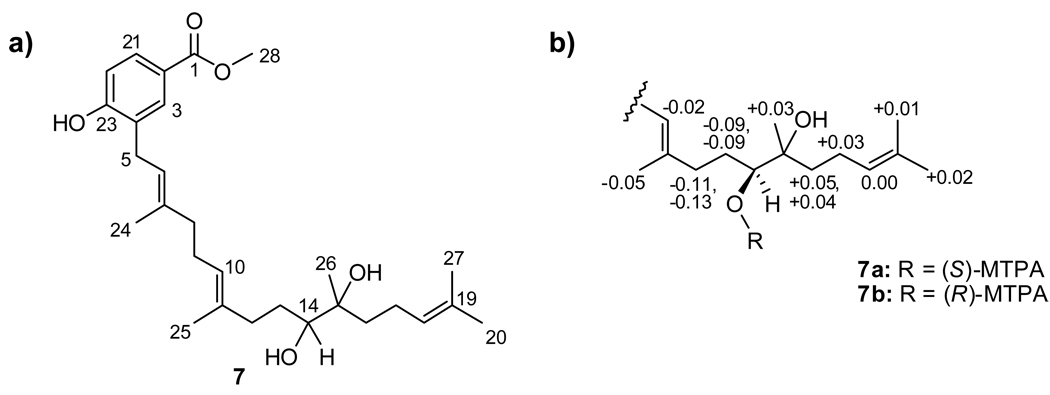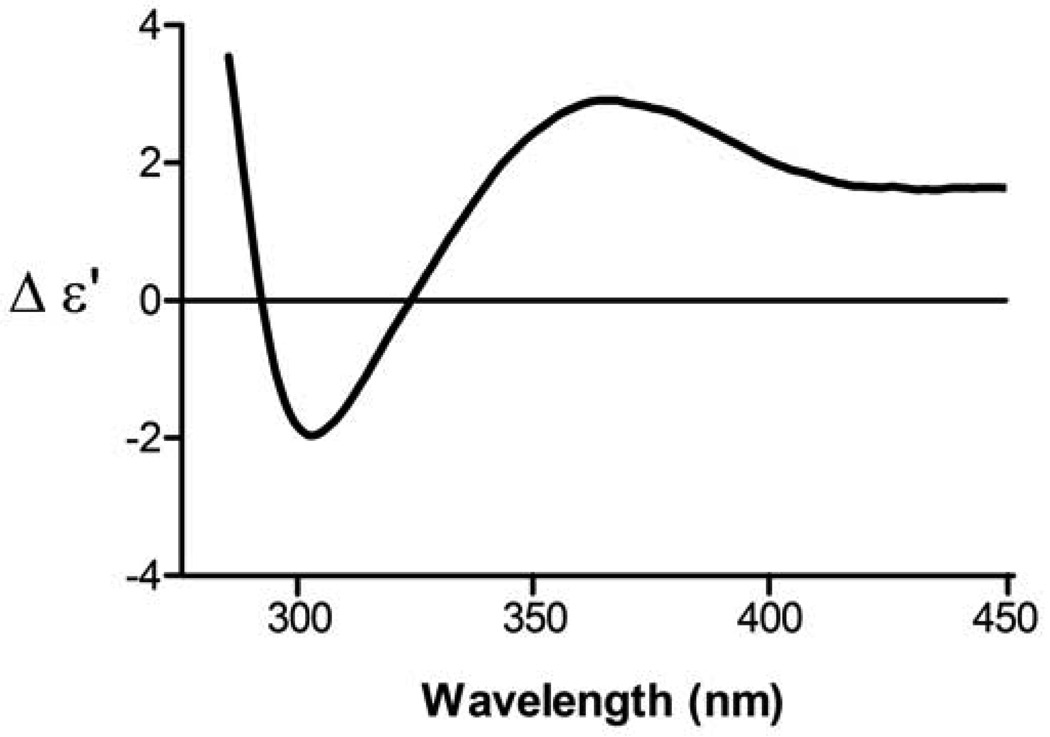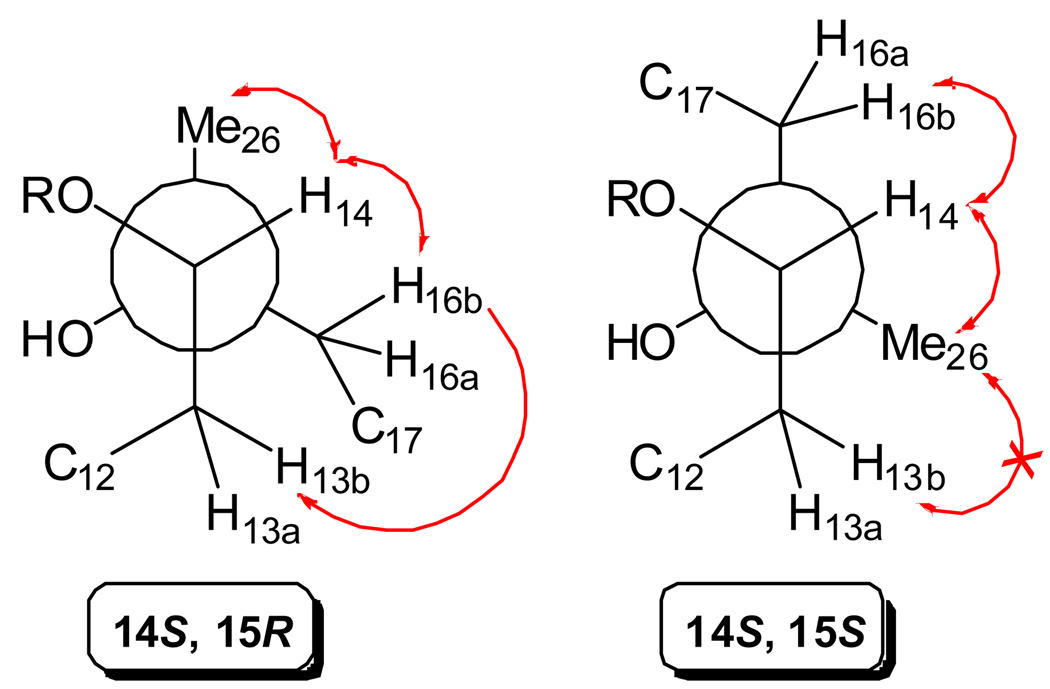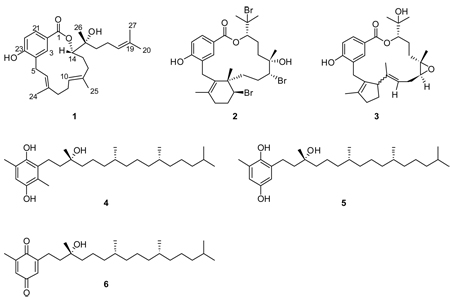Abstract
Three antimalarial meroditerpenes have been isolated from two Fijian red macroalgae. The absolute stereochemistry of callophycolide A (1), a unique macrolide from Callophycus serratus, was determined using a combination of Mosher’s ester analysis, circular dichroism analysis with a dimolybdenum tetraacetate complex, and conformational analysis using NOEs. In addition, two known tocopherols, β-tocopherylhydroquinone (4) and δ-tocopherylhydroquinone (5), were isolated from Amphiroa crassa. By oxidizing 5 to the corresponding δ-tocopherylquinone (6), antimalarial activity against the human malaria parasite Plasmodium falciparum was increased by more than 20-fold.
Keywords: Callophycus serratus, Amphiroa crassa, natural product, drug discovery, red macroalgae
Natural products have been the source of the most successful antimalarial drugs to date, including most notably the quinines and artemisinins.1,2 The design and development of many synthetic antimalarial drugs has largely been inspired by these and other antimalarial natural products.1 Thus, the discovery of novel chemistry from natural sources could provide new scaffolds for the development of much needed antimalarial treatments. We previously discovered a structurally-novel class of brominated diterpenoid macrolides, called bromophycolides, from the Fijian red macroalga Callophycus serratus,3–4 and several bromophycolides exhibited submicromolar activity against the human malaria parasite Plasmodium falciparum.5–6 Our continued efforts to uncover antimalarial natural products from understudied tropical red macroalgae led us to explore potent activity from two red algae in our library, thus leading to the identification of an unusual non-brominated macrolide we named callophycolide A (1) and two known tocopherols, β-tocopherylhydroquinone (4) and δ-tocopherylhydroquinone (5) from the coralline alga Amphiroa crassa.
Callophycus serratus (family Solieriaceae, order Gigartinales, class Rhodophyceae, phylum Rhodophyta) was collected at depths of 2–3 m from Yanuca in the Fiji Islands (18° 23’ 57” S, 177° 57’ 59” E), and Amphiroa crassa (family Corallinaceae, order Corallinales, class Florideophyceae, phylum Rhodophyta) was collected at a depth of 20 m from the Coral Coast, Fiji (18° 12’ 15” S, 177° 39’ 35” W). Frozen C. serratus and A. crassa were each extracted with MeOH and MeOH:DCM (1:1, 1:2) and subjected to liquid partitioning between MeOH:H2O (9:1) and petroleum ether. The MeOH:H2O ratio of each species’ aqueous fraction was then adjusted to 3:2 and partitioned against chloroform. The chloroform-soluble fraction for each species was then separated with multiple rounds of reversed-phase C18 HPLC (Alltech Alltima C18, 5 µm, 10 × 250 mm) with a gradient of MeCN (aq) to yield 1 from C. serratus and 4–5 from A. crassa.
Unlike previously isolated bromophycolides3–6, callophycolide A (1) did not display a characteristic brominated isotopic pattern with HRESIMS, but showed an [M + H]+ m/z of 427.2825, appropriate for a formula of C27H38O4. The p-hydroxybenzoate segment common to all reported Callophycus serratus secondary metabolites3–7 remained intact, apparent from the 13C and 1H NMR chemical shifts for positions 3 (δC 131.1;δH 7.85), 21 (δC 129.6; δH 7.73), 22 (δC 114.8; δH 6.78), and 23 (δC 158.0; OH δH 5.83). HMBC correlations from H2-5 (δ 3.17, 3.49) to C-3, C-4 (δ 127.7), and C-23 connected the C-5 methylene to the p-hydroxybenzoate fragment, as in bromophycolides, but surprisingly C-5 was not connected to a substituted cyclohexene. Instead, a linear isoprene unit was established through COSY correlations between both H2-5 protons and H-6 (δ 5.45), as well as HMBC correlations from Me-24 (δ 1.60) to C-6 (δ 122.7), C-7 (δ 136.8), and C-8 (δ 39.3). COSY correlations failed to establish the vicinal relationship of H2-8 (δ 2.17, 2.27) and H2-9 (δ 2.15, 2.23) due to substantial chemical shift overlap; instead, HSQC-TOCSY correlations were used to connect well-resolved carbons at C-8 and C-9 (δ 23.8; Figure 1). COSY correlations between both H2-9 protons and H-10 (δ 5.19) and HMBC correlations from Me-25 (δ 1.59) to C-10 (δ 123.5), C-11 (δ 135.2), and C-12 (δ 35.8) connected a second isoprene unit within 1. HMBC correlations from H-14 (δ 4.75) to C-1 (δ 169.2), C-12 (δ 35.8), C-13 (δ 29.2), C-15 (δ 74.8), and Me-26 (δC 22.0) provided strong evidence in support of a macrocyclic lactone framework and accounted for a third isoprene fragment. Me-26 (δH 1.16) showed strong HMBC signals to C-14 (δ 82.1), C-15, and C-16 (δ 40.0), while vicinal COSY correlations established a C-16—C-17—C-18 connectivity. Allylic coupling was observed with weak COSY correlations between H-18 (δ 5.10) and both Me-20 (δ 1.66) and Me-27 (δ 1.60), establishing the diterpene head. This structural feature was further confirmed by HMBC correlations from both Me-20 and Me-27 to C-18 (δ 124.3), C-19 (δ 131.8), and to each other, completing the planar connectivity of 1.
Figure 1.
Key 2D NMR spectroscopic correlations establishing the connectivity of callophycolide A. a) 1H-1H COSY (bold), HMBC (red single-headed arrows), and HSQC-TOCSY (blue double-headed arrow) correlations; b) ROESY (red double-headed arrows) correlations establishing configurations for macrocyclic olefins in 1.
ROESY data were used to assign the configurations of the olefins within the macrocyclic ring. NOEs observed between H-6 and both H2-8 protons and between Hb-5 (δ 3.49) and Me-24 (δ 1.60) supported an E configuration for Δ6,7. Similarly, ROESY correlations between H-10 (δ 5.19) and Ha-12 (δ 1.87) as well as between Hb-9 (δ 2.23) and Me-25 (δ 1.59) suggested an E configuration for Δ10,11 (Figure 1b).
Absolute configuration at C-14 was determined by analysis of Mosher ester data8 derived from the methylated hydrolysis product 7 (Figure 2a). Hydrolyzed product 7 was acylated with each of R-(−)- and S-(+)-α-methoxy-α-(trifluoromethyl)phenylacetyl chloride (MTPA-Cl) to produce the corresponding S- and R-MTPA esters 7a and 7b, respectively. Analysis of the 1H NMR and HSQC-TOCSY spectra obtained for both esters permitted the assignment of the proton chemical shifts in proximity of the esterified carbon. Calculation of the ΔδS–R values established the absolute configuration of C-14 as S based upon empirical rules proposed by Ohtani et al.8 (Figure 2b).
Figure 2.
Mosher’s ester analysis of callophycolide A (1). a) Methanolysis product 7; b) and ΔδS-R values (ppm) for Mosher esters 7a and 7b from 7.
Solution of the configuration at C-15 proved to be challenging relative to other stereocenters in 1. Frelek et al. reported a circular dichroism (CD) spectroscopic method for determining the absolute configuration of restricted and flexible vicinal diols complexed with dimolybdenum tetraacetate.9–10 After ligation to Mo2, free-rotation about flexible diols is substantially reduced due to steric requirements of the transition metal complex. The energetically preferred conformation of a flexible diol ligated to Mo2 in a bidentate fashion is an antiperiplanar orientation of the O—C—C—R groups, with the bulky R-groups pointing away from the Mo2 complex and the vicinal diols in a gauche conformation.10 The CD spectrum of the in situ formed Mo2 complex with 7 showed a negative Cotton effect at 310 nm, which corresponded to a negative O—C—C—O dihedral angle (Figure 3) as predicted by the helicity rule proposed by Frelek et al.9 Molecular modeling was performed with HyperChem using the molecular mechanics MM+ force field method and conjugate gradient Polak Ribiere algorithm with RMS gradient of 0.001 kcal/Å·mol as described in Górecki et al.10 Molecular modeling of a 14S, 15S configuration in accordance with the lowest energy conformation predicted a positive O—C—C—O dihedral angle, ruling out this diastereomer and suggesting a 14S, 15R configuration, whose preferred conformation of the dimolybdenum complex could have yielded either a positive or negative torsional angle. A stable conformation of 1 could involve intramolecular hydrogen bonding between the C-15 hydroxy and C-1 carbonyl, as predicted by molecular modeling (Supplemental Data). This places the C-15 hydroxy anti to H-14 which is supported by NOEs observed between H-14 and both Hb-16 (δ 1.52) and Me-26; however this conformation is feasible for both 15R and 15S. An NOE correlation from Hb-16 to Hb-13 (δ 2.03) could differentiate between a 15R or 15S configuration (Figure 4), and inspection of 1D NOE spectra (irradiating Hb-16, acquired at −10 °C) showed the presence of this correlation. Lack of NOEs between H2-13 protons and Me-26 implied an anti conformation of these groups and further supported a 15R stereochemical assignment (Figure 4). Overall, the combination of Mosher’s ester analysis, CD analysis with a dimolybdenum tetraacetate complex, and conformational analysis using NOEs argue strongly for an absolute stereochemistry of 14S, 15R for 1.
Figure 3.
CD spectrum of the in situ Mo2-complex formed with methanolysis product 7.
Figure 4.
Observed NOE correlations (ROESY = double-headed arrow; 1D NOE = single-headed arrow) used to establish the relative stereochemistry at C-15 as R in 1. NOEs that were not observed are indicated by an “x” through the arrow.
Previously reported bromophycolides3–6 (e.g., bromophycolide A, 2) and related non-macrocyclic callophycoic acids and callophycols7 exhibit antimalarial IC50 values ranging from 0.3 to >100 µM, providing a detailed structure-activity relationship (SAR) analysis for this class of compounds.6 The identification of 1 provides additional insight into the SAR for 33 known C. serratus metabolites, in that 1 retains moderate antimalarial activity (IC50 = 5.2 µM, Table 1) despite the complete absence of bromine atoms, similar to debromophycolide A (3), whose antimalarial IC50 is > 100 M. Furthermore, 1 has a carbon skeleton different than other bromophycolides, although its skeleton is not unprecedented and is shared with tocopherols.11 The lactonization pattern through C-14 in 1 is unique, and the absence of a substituted cyclohexene ring (compared to 2, IC50 = 0.7 µM) suggests that this ring is not essential but can enhance antimalarial activity. Callophycolide A (1) was tested against 12 human cancer cell lines, exhibiting only modest cytotoxicity against most cell lines (IC50 values ranging from 16–22 µM); the two most sensitive cell lines, CCRF-CEM (leukemia tumor cells) and SHP-77 (lung tumor cells), showed moderate IC50 values of 7.5 and 9.2 µM, respectively. Callophycolide A (1) inhibited bacterial growth in the low micromolar range but was ineffective at deterring growth of human pathogenic fungi (Table 1).
Table 1.
| antimalarial activity |
antimalarial activity |
antimicrobial MIC (µM) | ||||
|---|---|---|---|---|---|---|
| cmpd. | IC50 (µM) | IC50 (µM)a | MRSAb | VREFc | M. tuberculosis | ARCAd |
| 1 | 5.2 | 18 | 9.1 | 9.1 | 12 | >250 |
| 2 | 0.7 | 6.7 | 5.9 | 5.9 | 11 | 49 |
| 3 | >100 | >76 | NT | NT | >100 | >500 |
| 4 | 190 | >25 | >500 | >500 | NT | NT |
| 5 | 220 | >25 | >500 | >500 | >100 | NT |
| 6 | 10 | NT | >500 | >500 | NT | >500 |
Median of 12 cell lines
Methicillin-resistant Staphylococcus aureus
Vancomycin-resistant Enterococcus faecium
Amphotericin B-resistant Candida albicans
NT indicates not tested due to insufficient material
Purified from extracts of A. crassa, tocopherylhydroquinones 4–5 were identified by a detailed analysis of their 1- and 2D NMR and MS spectral data and compared to related tocopherols previously reported.12–13 While 1H and 13C NMR spectral data are available in the literature for vitamin E and related tocopherols, complete spectral data for 4–5 were lacking. Therefore, we provide full NMR spectral data for 4–5 in the present study (see Supplementary Data).
Tocopherols have been isolated and characterized from various brown algae including Sargassum fallax13 and Cystoseira stricta,14 but the identification of 4–5 represents the first isolation of tocopherols from red algae. This class of molecules has been shown to have a variety of functions in terrestrial vascular plants, including scavenging lipid peroxy radicals and preventing propagation of lipid peroxidation in membranes; protecting lipids and other membrane components by quenching and reacting with singlet oxygen and thus providing photoprotection for chloroplasts; and increasing membrane rigidity.15 While a number of tocopherol derivatives have been isolated from brown macroalgae, their ecological functions are unclear. These compounds may function similarly as in vascular plants given the high exposure of many macroalgae to UV radiation, however this hypothesis has not been tested.
The biomedical potential of tocopherols and related compounds mainly relate to their antioxidant activities, as these compounds are well established in their radical scavenging activity.16 Hydroquinones 4–5 showed weak activity against P. falciparum (IC50 values of 190 and 220 µM for 4 and 5, respectfully, Table 1), but oxidation of 5 to quinone 6 increased the antimalarial activity by more than 20-fold to an IC50 of 10 µM, suggesting that the quinine functionality is essential for activity for tocopherol-related compounds. Unfortunately, following bioassays we did not have enough 4 to oxidize to the corresponding β-tocopherylquinone. This is the first report of tocopherols in red macroalge and of antimalarial activity for tocopherols 4–6. Furthermore, 4–6 displayed no activity in cancer and microbial assays, although 6 was not tested against human cancer cells due to insufficient material. Compounds 1 and 6 are unusual scaffolds when compared to current natural antimalarial treatments, such as the quinines and artemisinins. These meroditerpene macroalgal compounds could inspire the development of novel templates for future antimalarial drugs.
Supplementary Material
Acknowledgements
This research was supported by the U.S. National Institutes of Health’s International Cooperative Biodiversity Groups program (Grant No. U01 TW007401). We thank the Government of Fiji for the permission to perform research in their territorial waters and for permission to export samples. We especially thank the Roto Tui Serua and the people of Yanuca Island for facilitating this work. We thank M. Sharma and K. Feussner for extractions; T. Davenport and S. Engel for antimicrobial assays; M.C. Sullards and D. Bostwick for mass spectroscopic analyses; L. Gelbaum for NMR assistance; A. Bommarius and T. Rogers for use of their spectropolarimeter; and I. Mamajanov, A. Engelhart, and N.V. Hud for help and use of their CD spectrophotometer.
Footnotes
Publisher's Disclaimer: This is a PDF file of an unedited manuscript that has been accepted for publication. As a service to our customers we are providing this early version of the manuscript. The manuscript will undergo copyediting, typesetting, and review of the resulting proof before it is published in its final citable form. Please note that during the production process errors may be discovered which could affect the content, and all legal disclaimers that apply to the journal pertain.
Supplementary Data
Experimental details and 1 and 2-D NMR spectroscopic data for 1 and 4–5 are available free of charge via the Internet.
Compound data
Callophycolide A (1): pale yellow oil (4.0 mg, 0.021% dry mass); [α]24D +200 (c 0.01, MeOH); UV (MeOH) λmax (log ε) 260 (4.06) nm; 1H, 13C, NOE, COSY, HSQC-TOCSY, and HMBC NMR data, see Supplementary Data; HRESIMS [M + H]+ m/z 427.2825 (calcd for C27H39O4, 427.2842) and [M + Na] m/z 449.2623 (calcd for C27H38O4Na, 449.2668).
β-Tocopherylhydroquinone (4): clear oil (1.2 mg, 0.003% plant dry mass); [α]24D +2.2 (c 0.06, MeOH); UV (MeOH) λmax (log ε) 255 (3.93) nm; 1H, 13C, COSY, and HMBC NMR data, see Supplementary Data; HRESIMS [M-H-H2O]− m/z 415.3553 (calcd for C28H47O2, 415.3576).
δ-Tocopherylhydroquinone (5): brown oil (2.8 mg, 0.006% plant dry mass); [α]24D +1.3 (c 0.14, MeOH); UV (MeOH) λmax (log ε) 255 (3.56) nm; 1H, 13C, COSY, and HMBC NMR data, see Supplementary Data; HRESIMS [M-H-H2O]− m/z 401.3414 (calcd for C27H45O2, 401.3419); [2M-H-2H2O]− m/z 803.6876 (calcd for C54H91O4, 803.6917).
References and Notes
- 1.Kaur K, Jain M, Kaur T, Jain R. Bioorg. Med. Chem. 2009;17:3229. doi: 10.1016/j.bmc.2009.02.050. [DOI] [PubMed] [Google Scholar]
- 2.Newman DJ, Cragg GM. J. Nat. Prod. 2007;70:461. doi: 10.1021/np068054v. [DOI] [PubMed] [Google Scholar]
- 3.Kubanek J, Prusak AC, Snell TW, Giese RA, Hardcastle KI, Fairchild CR, Aalbersberg W, Raventos-Suarez C, Hay ME. Org. Lett. 2005;23:5261. doi: 10.1021/ol052121f. [DOI] [PMC free article] [PubMed] [Google Scholar]
- 4.Kubanek J, Prusak AC, Snell TW, Giese RA, Fairchild CR, Aalbersberg W, Hay ME. J. Nat. Prod. 2006;69:731. doi: 10.1021/np050463o. [DOI] [PMC free article] [PubMed] [Google Scholar]
- 5.Lane AL, Stout EP, Lin AS, Prudhomme J, Roch KL, Fairchild CR, Franzblau SG, Hay ME, Aalbersberg W, Kubanek J. J. Org. Chem. 2009;74:2736. doi: 10.1021/jo900008w. [DOI] [PMC free article] [PubMed] [Google Scholar]
- 6.Lin AS, Stout EP, Prudhomme J, Roch KL, Fairchild CR, Franzblau SG, Hay ME, Aalbersberg W, Kubanek J. J. Nat. Prod. 2010;73:275. doi: 10.1021/np900686w. [DOI] [PMC free article] [PubMed] [Google Scholar]
- 7.Lane AL, Stout EP, Hay ME, Prusak AC, Hardcastle K, Fairchild CR, Franzblau SG, Roch KL, Prudhomme J, Aalbersberg W, Kubanek J. J. Org. Chem. 2007;72:7343. doi: 10.1021/jo071210y. [DOI] [PMC free article] [PubMed] [Google Scholar]
- 8.Ohtani I, Kusumi T, Kakisawa Y. J. Am. Chem. Soc. 1991;113:4092. [Google Scholar]
- 9.Frelek J, Klimek A, Ruskowska P. Curr. Org. Chem. 2003;7:1081. [Google Scholar]
- 10.Gorecki M, Jablonska E, Kruszewska A, Suszczynska A, Lipkowska ZU, Gerards M, Morzycki JW, Szczepek WJ, Frelek J. J. Org. Chem. 2007;72:2906. doi: 10.1021/jo062445x. [DOI] [PubMed] [Google Scholar]
- 11.Shin TS, Godber JS. J. Chromatogr. A. 1994;678:49. [Google Scholar]
- 12.Melchert HU, Pollok D, Pabel E, Ruback K, Stan HJ. J. Chromatogr. A. 2002;976:215. doi: 10.1016/s0021-9673(02)00941-x. [DOI] [PubMed] [Google Scholar]
- 13.Reddy P, Urban S. Phytochemistry. 2009;70:250. doi: 10.1016/j.phytochem.2008.12.007. [DOI] [PubMed] [Google Scholar]
- 14.Amico V, Oriente G, Piattelli M, Ruberto G, Tringali C. Phytochemistry. 1982;20:421. [Google Scholar]
- 15.Munne-Bosch S, Alegre L. Crit. Rev. Plant Sci. 2002;21:31. [Google Scholar]
- 16.Niki E. Redox Rep. 2007;12:204. doi: 10.1179/135100007X200353. [DOI] [PubMed] [Google Scholar]
Associated Data
This section collects any data citations, data availability statements, or supplementary materials included in this article.







